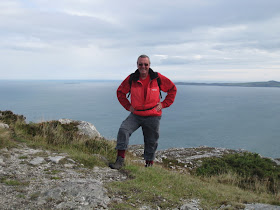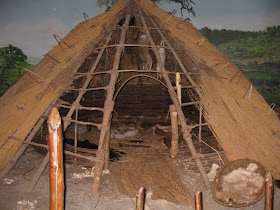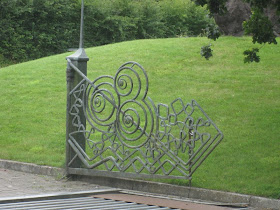Our ferry from Dublin arrived right on time, after the smoothest of trips, at 4:30 pm. We were visiting Denise and Gino, who we met way back in Sicily last November. As we pulled out of the ferry terminal, there was Gino, standing by the side of the road waiting for us. He was such a welcome sight and looked so good! He directed us to a parking lot where excited hugging commenced; then we segregated by gender and I rode to their house with Denise and Gino went with Chuck. They live on The Mountain, in Holyhead, Anglesey, Wales, up a very narrow road. Gino guided Homer, with assistance from Chuck, into a parking space with only inches to spare.
We chatted for awhile, drank wine and tea, then followed them out the door for a lovely walk down the mountain toward the port. The view from their historic cottage, Snowdon View, is spectacular.



Many different artists have painted Denise's house. I took a photo of a one artist's work.

Our walk took us to a nearby park. The sun was out (a welcome change!) and it was warm--what a great way to start a visit.


When we first met them, they had only known each other for about five months and had been traveling together in his small camper for three. Clearly, they are made for each other; they decided to get married in April. In fact, they had two celebrations--one in Wales, and another two months later, in Italy. The second celebration took place at a campground Gino has frequented for years; they dressed for the party inside their new, larger camper. We were so glad to see them and to see them so happy!
Gino, a gourmet Italian, loves to cook; he prepared an incredible dinner while Denise showed us around the cottage, which was a former miner’s cottage from 1860. It is a listed house for historic preservation. We started with pasta carbonara—I am so annoyed with myself for not taking a picture. It was delicious and I plan to try it at home. Our second course was aubergine (worldspeak for eggplant) with tomatoes, garlic and mozzarella cheese.

For dessert, Denise served strawberries with lemon juice, sugar and vanilla ice cream. We were stuffed! We got partially caught up during the meal and made plans for a hike the next day.
They are lucky enough to live in a gorgeous area, on the Gulf Stream, with hiking trails all around them. We drove a short way to the start of a coastal walk, taking Lucy, Denise’s loyal dog.


They even have their very own passage grave in the area.

One of several sandy beaches

It was cloudy and breezy, but a perfect day for hiking. We passed through several kissing gates along the way, and a ladder for climbing over the rock wall bordering the military reservation.


I was very excited by the Oystercatchers. Gino assisted with getting one of them in flight for this picture by clapping his hands; when it wouldn't budge, he threw a stone against the rocks and it soared away.


Remember those resting cows in Ireland? They have them in Wales, too. According to Gino, this means it’s going to rain. So what’s up with the sun shining now?

This is how the cow gets back up—a lot like a camel unfolding.

We stopped for cones at the ice cream van on the beach. Lucy greatly enjoyed the last bit of all of our cones.

Home again, Denise made the best lamb I have ever tasted, with perfectly cooked carrots and potatoes. Did I mention that this visit was about food and walking?

Not long after we finished dinner, Denise's son Craig, his wife Marie, their daughter Emily and dogs Oscar and Scampi arrived from England. They stopped by for a couple of days on their way to Ireland, where Marie is from. We really enjoyed getting to know them. What a very nice family!
I guess the cows were right--The next day was quite rainy; so all seven of us drove to an art gallery/museum and out to lunch. We found several watercolors and one oil painting of Denise's house. Along the way, we stopped at a village with the longest name in Wales; as a publicity stunt, it has been highly successful. That night, Gino produced another incredible meal of lamb and pork with rosemary and lots of garlic.
Longest name




Emily and her dog Oscar

Today, the sun came out and we headed up The Mountain. What a wonderful final day together. Sadly, Craig, Marie and Emily left on the 5 pm ferry for their vacation.
Hiking up The Mountain

Gino getting to the top

At the top!

Denise and Gino have some charming friends, John and Pauline. We stopped by their place along the way. It is gorgeous, with spectacular views of the water and town below. We all drank tea and visited before we headed out again. Craig and Gino hiked back home to make lunch, while the rest of us made our way to the lighthouse.
John and Pauline's side "yard"

Pauline and John

Beautiful heather and gorse, which is growing in abundance everywhere.

View along the way

Lighthouse

Mountain climbers practicing

We loved these poems, written by Gino and Denise for their wedding:
A Dream Come True, by Gino
You appeared to me,
Like a sweet song in a green valley,
I was miserable, lost, alone,
An island in the ocean.
But you made me a man of better times,
Gentle, sentimental and romantic.
The man I was is no longer,
Now that your beautiful, loving lips have said
I swear.
I Found Him, By Denise
I dreamt of castles in the air
And here I found my soul mate.
So different, yet so together
In him I see myself as in a mirror.
So new, so unexpected,
He smiles, I melt.
My world spins around my head
Turns upside down and is reborn in him.
We met a thousand years ago
Yet life is only at its start.
As though it was meant to be this way;
In him I found happiness and joy.
Tears of laughter and sadness
As we learn a new way of living.
Walking hand in hand serenely
Through this beautiful world.
Planning a route
For our future together
The meaning of my life
I found in him.

























